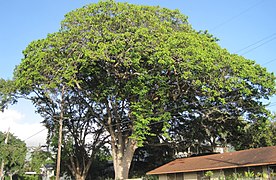
Hura crepitans
| Hura crepitans | |
|---|---|

| |
|
Scientific classification | |
| Kingdom: | Plantae |
| Clade: | Tracheophytes |
| Clade: | Angiosperms |
| Clade: | Eudicots |
| Clade: | Rosids |
| Order: | Malpighiales |
| Family: | Euphorbiaceae |
| Genus: | Hura |
| Species: |
H. crepitans
|
| Binomial name | |
|
Hura crepitans | |
| Synonyms | |
Hura crepitans, the sandbox tree, also known as possumwood, monkey no-climb, assacu and jabillo, is an evergreen tree in the family Euphorbiaceae, native to tropical regions of North and South America including the Amazon rainforest. It is also present in parts of Tanzania, where it is considered an invasive species. Because its fruit explodes when ripe, it has also received the colloquial nickname the dynamite tree.
Description
The sandbox tree can grow to 60 metres (200 ft), and its large ovate leaves grow to 60 cm (2 ft) wide. They are monoecious, with red, un-petaled flowers. Male flowers grow on long spikes, while female flowers grow alone in leaf axils. The trunk is covered in long, sharp spikes that secrete poisonous sap. The sandbox tree's fruits are large, pumpkin-shaped capsules, 3–5 cm (1–2 in) long, 5–8 cm (2–3 in) diameter, with 16 carpels arranged radially. Its seeds are flattened and about 2 cm (3⁄4 in) diameter. The capsules explode when ripe, splitting into segments and launching seeds at 70 m/s (250 km/h; 160 mph). One source states that ripe capsules catapult their seeds as far as 100 m (330 ft). Another source states that seeds are thrown as far as 45 m (150 ft) from a tree, averaging about 30 m (100 ft).
Habitat
This tree prefers wet soil, and partial shade or partial to full sun. It is often cultivated for shade. Sandbox trees are tropical trees and prefer warmer, more humid environments.
Uses
Fishermen have been said to use the milky, caustic sap from this tree to poison fish. The Caribs made arrow poison from its sap. The wood is used for furniture under the name "hura". Before more modern forms of pens were invented, the trees' unripe seed capsules were sawn in half to make decorative pen sandboxes (also called pounce pots), hence the name 'sandbox tree'. It has been documented as a herbal remedy, and is available online.
Gallery
Large sandbox tree in Honolulu
Hura crepitans in Vietnam
Hura crepitans in Saint John, U.S. Virgin Islands
External links
- Center for Wood Anatomy Research, details about the wood of the Sandbox tree
- (in Portuguese) University of São Paulo: Hura crepitans photos
- www.maya-ethnobotany.org seedpod explosion video






